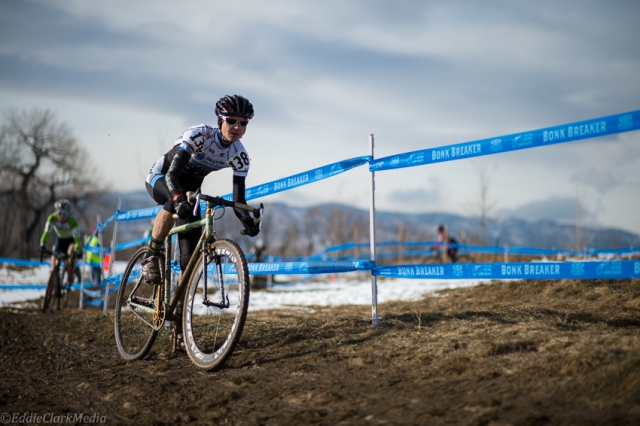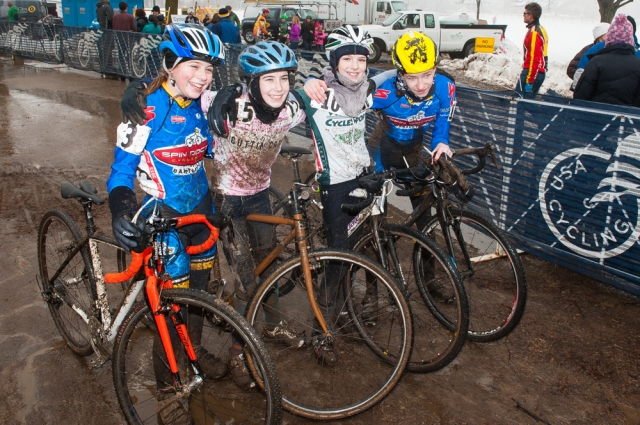How to Start Racing Cyclo-cross
What Is Cyclo-cross?
It is that crazy sport your friends have been talking about! Cyclo-cross, often time called ‘cross or CX, is a sport that has its origins in Europe in the early 1900s and takes place in fall and winter months. ‘Cross is wildly popular in countries like Belgium and Holland and is currently the fastest growing cycling discipline in the U.S.
So what is cyclo-cross? Imagine steeplechase with a bike, and mud — if you are lucky, lots and lots of mud! Depending on experience level, racers compete for between 30 minutes and one hour by racing multiple laps around a short course that can consist of grass, dirt, mud, pavement, short, steep hills, off-camber sections and a few obstacles. Typically, the course is about 1.5-2 miles long.
The obstacles can be anything from low, wood planks (called barriers), stairs, short hills too steep to ride up or logs. The obstacles force the rider to get off and on their bike multiple times a lap. Sometimes, parts of the course are too slippery or slow to ride and racers pick up their bike and run with it. There is a technique to dismounting and re-mounting your bike quickly and experienced riders are very good at this.
Cyclo-cross specific bikes look very similar to a road bike but have more clearance around the tires for mud, have a different type of braking system — either a cantilever or disc brakes — and have wider tires with knobs on them similar to mountain bike tires. That said, you do not need a cyclo-cross bike to race; you can ride a mountain bike or a road bike with wider tires (skinny tires aren’t recommended).
Events are separated into races for riders of different categories based on experience. Competitors in each race all line up together (called a mass start) and start the race together at the sound of the official’s whistle. The officials will hold up laps cards at the start/finish line indicating how many laps remain in the race. The finish is pretty simple: first person across the finish line on the last lap wins (unless you have been lapped by the leader of the race, of course.)
What to Expect
Expect something between a mountain bike race, a criterium, and maybe a cross-country running race. But don’t worry if you have never done any of those other events! Cyclo-cross is perfect for new racers. The speeds tend to be a bit slower due to the terrain. Drafting is not really much of an advantage, so you don’t have to ride very close to other riders. In fact, unlike in road races, the race usually breaks up into individual riders and small groups of one or two racers very quickly.
Another thing that makes it perfect for new racers is that there is very little pressure. There is no group you have so stay with (again, because there is no drafting), so you don’t have to worry about getting dropped. Everyone just races at his or her own pace. Some people are faster, some people are slower, but everyone still cheers for you! If you are worried about part of the course that might be too difficult, don’t worry, you can just get off your bike and walk or run. That’s okay in ‘cross!
A few more reasons why ‘cross is so awesome!
Cyclo-cross races are short. This means that you don’t have to be on a strict training program to compete. You can train as much or as little as you want to, still have a well-balanced life and show up, get a great workout, and have a super time. It also it means that the race won’t take up your entire day. That said, many people make it a day at the races because it is so much fun! Bring the whole family as there are usually events for all ages.
Cyclo-cross is a very spectator-friendly sport and everyone will have fun hanging out with the other spectators and cheering for the racers as they roll around breathing hard, sometimes covered in mud. Cyclo-cross races are typically held closer to urban areas than a typical road or mountain bike race as many of them are held in city or county parks.
On top of all that, you don’t need to spend a ton of money to get started. While there are all types of fancy ‘cross specific equipment options, you can pretty much race on anything (though a road bike with skinny tires isn’t recommended), and flat pedals are perfectly acceptable.
Watch a few ‘cross videos online or attend a local ‘cross race or clinic to see what all the hype is about and to give you a better idea of what to expect.
However, you should expect to have a great time! Expect to have people cheer for you. Expect to get a little dirty. Expect to maybe feel a little awkward, after all you are running and jumping over obstacles with a bike! After you have finished, expect to feel like that was the hardest 30 minutes of exercise that you have ever done, but in a good way! And expect to want to come back the next week!
What to Bring
- Bike: Cyclo-cross bike, mountain bike, hybrid/commuter bike (pretty much anything beside a road bike with skinny tires)
- Warm, dry clothes to change into afterwards. Don’t forget a warm hat and gloves!
- Rain gear (jacket, pants, boots, umbrella) if the forecast calls for it
- Towels and water to clean off with after the race if it is muddy or wet
- Plastic bag to put wet clothes into
- If it is USA Cycling race you will need a USAC license. You can or purchase a one-day license when you register at the event.
- Spare tubes/tires and pump
- Checkbook/cash for entry fees
- Food and water for after the race. Lots of people bring coolers with beverages and food to hang out afterwards and cheer on the other racers.
- Thermos with hot water or hot beverage if you expect it to be cold
- A cowbell for cheering
- A positive attitude!
What to Wear
When racing cyclo-cross it is better to bring too many clothes than too few. Since the weather is often wet and cold, always pack extras of almost everything.
- Two cycling shorts or bibs with a chamois (remember, no underwear needed) or skinsuit
- Two or more jerseys that are weather specific
- Leg/knee/arm warmers
- Warm base layers
- Cycling jacket
- Cycling cap, skull cap or ear cover if it is really cold
- Two or more pairs socks
- Bike shoes/Cleats
- Sunglasses: Good for eye protection against the mud
- Helmet (Even if you aren’t racing, every time you are on your bike you are required to wear a helmet)
- Gloves that are weather specific. Again bring a few different pairs so you can be ready for any kind of weather
Other Helpful Hints
- It is a good idea to ride the race course at least once before the race. This helps you learn what and where the obstacles are as well as the layout of the course. Plan on getting to the race venue early so you have time to take that practice lap.
- Since ‘cross is a fall/winter sport you may encounter inclement weather. Be prepared. Rain and cold temperatures can make the racing more fun and exciting, but it can also make everything more difficult. Leave extra time to get in and out of cold, wet clothing, and make sure you have everything you need to get warm and dry after your race. Being cold is no fun and can be dangerous, quickly turning a good day into bad one.
- Above all, have fun!
Emily Kachorek is an elite cyclo-cross and road cyclist from California. Emily has raced for USA Cycling’s national team in Europe and currently rides for Squid Bikes. You can follow her on Twitter at @EmilyKachorek.
Related Articles
- Cyclo-cross Racing for Beginners: Recipe for Success - Sep 30, 2011
- How to prep for your first cyclo-cross race - Sep 08, 2015
- The warm-up routine: Tips for the cyclo-cross racer - Nov 04, 2013
This Article Updated November 7, 2014 @ 06:14 PM For more information contact:




